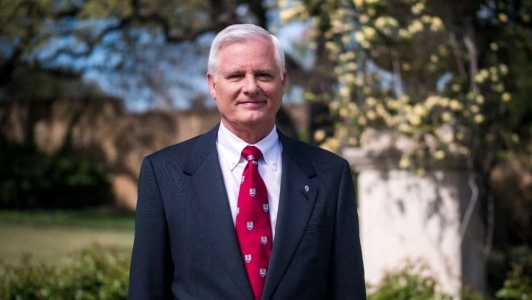You have /5 articles left.
Sign up for a free account or log in.

Jim Gallogly
University of Oklahoma
The University of Oklahoma’s new president waited out the weekend before shaking up the leadership team he inherited.
Six top administrators were laid off or retired Monday, the first workday Jim Gallogly was on the job as president. The university also announced a reorganization cutting the number of administrators reporting directly to the president from 25 to 17.
The changes were swift, even for a university that was clearly in line for a significant overhaul as it faces a multimillion-dollar budget gap while installing a new president for the first time in nearly a quarter of a century. Although some expected the new president to sweep in and clean house, Gallogly’s background as a business leader and the suddenness of his broad staffing moves mean Oklahoma is now a prime example of issues arising when a university hires a president from a nontraditional background who goes on to execute the leadership transition in a way perceived as unusual.
Oklahoma announced the administrative overhaul in a press release Monday, the day after Gallogly officially took over as president. The release quoted Gallogly thanking six now-former administrators -- Vice President for Administration and Finance Nick Hathaway, Chief Financial Officer Chris Kuwitzky, Chief Audit Executive Clive Mander, Senior Associate Vice President for Public Affairs Rowdy Gilbert, Executive Director of Federal Programs Scott Mason and Vice President of Government Relations Jonathan Nichols.
Some of the administrators were laid off and some decided to retire, Gallogly said in an interview. The new president, who had been on campus for several months after being selected for the job in March, had previously discussed retirement with several of the administrators. But they did not know their jobs would be ending before Monday, he said.
Oklahoma needed to simplify its administrative structure and budgeting process, Gallogly said in an interview. The changes aim to put administrators into a more traditional structure, he said.
“You simply can’t operate efficiently with 20-something direct reports,” he said. “Nobody else does it that way, and we shouldn’t.”
Nonetheless, the changes are wide-ranging and come as the university faces a particularly turbulent time. Observers wondered how Oklahoma can hope to replace so many administrators at once while also facing significant challenges.
The university has been losing $36 million per year and spends almost $70 million annually on debt service, Gallogly said at a Board of Regents meeting in June. Regents approved a $2.12 billion budget for the 2019 fiscal year with the understanding Gallogly will revise it, The Oklahoman reported. Without changes to the budget, the university is facing an operating loss of $14.5 million. The discussion prompted Gallogly's predecessor to issue a statement arguing the university's debt situation is not unusual and that the true threat to the institution is a lack of public funding.
Gallogly has experience turning around a struggling company but no background leading a university. He is a former petroleum and chemical company executive and major University of Oklahoma donor who earned his law degree from Oklahoma in 1977. He is credited with guiding LyondellBasell, where he served as chairman and CEO, out of bankruptcy.
He takes over for David L. Boren, a former Oklahoma governor and U.S. senator who was the university’s president for almost 24 years. Boren had been praised for raising money and building the university’s profile. But he’d also been the target of some criticism in 2013 when faculty members worried he was picking administrators in order to secure his legacy -- charges his defenders denied.
The staffing and organizational changes announced Monday have nothing to do with the former administration, Gallogly said.
“I’ve been in the corporate world, in the oil business,” Gallogly said. “My people aren’t really in higher ed, so no, it’s not about bringing in my own people. I’m a person who works with really strong teams and top people. We have ambitions and goals, and I want to make sure we have the best possible team.”
The restructuring is intended to simplify reporting, bring in “fresh, diverse perspectives” and improve the university’s cost structure, according to Oklahoma’s Monday news release. Gallogly did not provide a specific dollar amount that would be saved.
“We’re going to be working with each one of the colleges, each of the staff, to figure out what’s the right thing to do and make collective decisions,” he said. “We also have some ambitious goals, of doubling our research.”
In addition, the university wants to give faculty members raises and maintain existing tuition levels, Gallogly said.
Several current and former Oklahoma faculty members declined to comment on the record, saying the situation was evolving or that they had been away from campus recently. But some thought Gallogly had been signaling major changes for several weeks.
Two Faculty Senate leaders did go on the record, responding to questions jointly by email. Gallogly's decisiveness has been well established, said Megan Elwood Madden, a professor of geology and geophysics who is chair of the Faculty Senate, and Joshua Nelson, a professor of English and director of film and media studies who is Faculty Senate chair-elect. The Senate "looks forward to helping cultivate a similarly strong reputation for consensus-building and collaboration," they said.
"We are always saddened to hear about the departure of colleagues with whom we have worked," they said. "We understand that changes in leadership entail changes in administrative structure but remain as committed as ever to the fundamental principles of shared governance, and we have every expectation that President Gallogly will work closely with faculty concerning changes closer to our purview."
Nonetheless, the breadth and speed of the changes surprised those who closely watch college and university leadership transitions. Usually, new presidents spend time on the job studying an administrative structure before making major modifications, said Terry Franke, managing director of Franke Associates, a consulting firm that specializes in presidential transitions and board governance in higher education. It’s out of the ordinary for a president to make widespread changes to senior leadership teams on their first day on the job.
“It’s much more like a corporate executive to make changes like this when there is a crisis or the need,” Franke said.
Franke has also seen executive changes put in place by an outgoing president or board chair before the new president takes over. That sets the stage for the new president to restructure without his or her first official action being layoffs.
Generally, it takes time to get to know a campus, learn about its administrative team and decide whether executives are a good fit with a new president, said David Attis, managing director of strategic research at EAB. Attis declined to comment specifically on the Oklahoma situation but agreed to discuss broad trends in presidential transitions.
A president who has been tapped for a job and spent time on campus for several months might have had time to learn about an institution and accelerate his or her plans, Attis said. With tenures shortening, presidents are doing everything they can to manage stakeholders quickly.
And a new leader who follows a longtime president might have more to manage.
“We often hear that when there hasn’t been a change in a long time, there is a kind of accumulation of issues that need to be dealt with,” Attis said.
At Oklahoma, 25 executives reporting to the president was an unthinkable number to manage, according to Franke. Lowering the number of direct reports below the new level of 17 would be closer to typical structures, he added.
It’s too soon to say whether additional changes will be put in place in the future at Oklahoma, Gallogly said.
“The first thing we wanted to do is make sure we had part of the senior management team settled,” he said. “We have a lot of positions we’re going to be doing national searches for.”
Those positions are vice president and chief financial officer, vice president for human resources, vice president for development, vice president for student affairs, vice president for public affairs, executive director for government relations and chief auditor. Others will fill those roles on an interim basis until they are filled permanently.
For his part, Gallogly wasn’t particularly concerned with whether his actions at Oklahoma are more common in a corporate or higher educational setting.
“It depends on what the situation is at a business or at a university and whether a change needs to be made,” he said. “The question is, did it need to be done? And in my view and the view of the regents, it did.”
(Note: The headline on this article was changed from an earlier version because of reader concerns about the original's meaning.)








